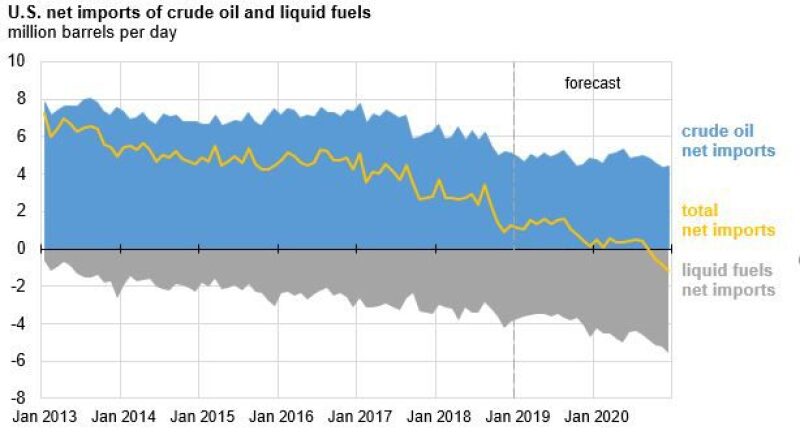A new report predicts that the US will soon become a net exporter of crude oil and other petroleum products.
While it is anticipated that the country will import at least 4.3 million B/D of crude oil in late 2020, outbound shipments of partially and fully refined products should tip the balance.
The development would represent a new milestone for the country, which has been revitalized by the unconventional revolution that began little more than a decade ago.
Estimates from the US Energy Information Agency’s (EIA) Short-Term Energy Outlook show that US crude and petroleum product imports fell from a combined average of 3.8 million B/D in 2017 to 2.4 million B/D last year. In November, the agency reported that the country was a net exporter for one week.
The forecast is that petroleum imports this year will not exceed 1.1 million B/D and will trend downward to about 100,000 B/D. By the fourth quarter, the EIA expects the threshold to be crossed on a longer-term basis as the US averages 900,000 B/D more in total petroleum exports than it is taking in.
Crude oil overtook gas liquids—included in the EIA’s petroleum product category—as the largest US petroleum export last year. Other petroleum products listed are distillates (e.g., diesel fuel), gasoline, and jet fuel.
Despite a recent decline in oil prices, US producers are likely to maintain robust output to make the reversal possible. The EIA says that average crude production is on track to rise from 2017’s record output of 10.9 million B/D to a new benchmark of 12.1 million B/D in 2020.
A number of new projects may help facilitate future exports including the dredging of a port facility in south Texas and a series of competing proposals to build new offshore export terminals along various points of the state’s coastline.
Most of the growth in output is expected to come from the Permian Basin region that spans Texas and New Mexico, and represents one of the most active oil and gas development areas on the planet. As of last week, 488 drilling rigs were active in the Permian, which was 100 more than the entirety of the Middle East, according to the Baker Hughes’ rig count.

Note: Liquid fuels include gasoline, distillate, hydrocarbon gas liquids, jet fuel, residual fuel oil, unfinished oils, other hydrocarbons/oxygenates, and other oils. Source: US Energy Information Administration.


